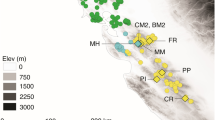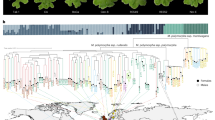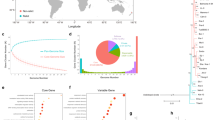Summary
A computer model has been developed to determine the effect of pollen and seed dispersal patterns on the probability of fixation and time to near-fixation of a rare advantageous gene in a plant population composed of 225 individuals. In the model, pollen and seed dispersal are according to four schedules (i) zero distribution, (ii) stepping-stone distribution, (iii) leptokurtic distribution, (iv) or random distribution. All combinations of pollen and seed dispersal schedules are treated. Relative fitnesses are assigned to three genotypes, AA, Aa, and aa, the latter always being the superior type. Relative fitness takes the form of competitive ability among the several seedlings germinating at each of the 225 safe sites in the population.
The probability of fixation of a rare advantageous recessive gene (a = 0·013) is inversely correlated with neighbourhood size. Restricted pollen and seed movements also retard the tempo of gene substitution relative to that expected with panmixia. Decreasing the intensity of competition has the same effect.
Gene frequency heterogeneity among subpopulations arises as a by-product of gene flow restriction, with graded patchworks of gene frequencies being most prominent when pollen and seed dispersal is narrow.
We considered the consequences of three receipt patterns (edge, leptokurtic, and random) of extraneous genes via pollen from a population located in a prescribed direction from the recipient. If the gene is advantageous, the more restricted the distribution to one edge of the population, the slower the tempo of gene substitution. If the gene is detrimental, the equilibrium gene frequency is depressed by restricting the deposition of pollen to the edge. In both cases non-random receipt yields properties very different from that when random immigration is assumed.
The literature indicates that gene flow within and between populations is non-random in plants. Our simulation demonstrates that abandoning the notion of panmixia will be a major step in understanding the dynamics and statistics of gene frequency change in plants.
Similar content being viewed by others
Article PDF
References
Bradshaw, A D. 1972. Some evolutionary consequences of being a plant. In Th. Dobzhansky, M. K. Hecht, and W. G. Steere (eds.), Evolutionary Biology, Vol. 5, pp. 21–44. Appleton-Century-Crofts, New York.
Crow, J F, and Maruyama, T. 1971. The number of neutral alleles maintained in a finite geographically structured population. Theoret Pop Biol, 2, 437–453.
Fisher, R A. 1930. The Genetical Theory of Natural Selection. Clarendon Press, Oxford.
Kimura, M. 1953. Stepping stone model of population. Ann Rep Nat Inst Genetics, 3, 63–65.
Kimura, M, and Maruyama, T. 1971. Pattern of neutral polymorphism in a geographically structured population. Genet Res Camb, 18, 125–133.
Kimura, M, and Ohta, T. 1971. Theoretical Aspects of Population Genetics. Princeton Univ. Press, Princeton, New Jersey.
Kimura, M, and Weiss, G H. 1964. The stepping stone model of population structure and the decrease of genetic correlation with distance. Genetics, 49, 561–576.
Levin, D A, and Kerster, H W. 1971. Neighbourhood structure in plants under diverse reproductive methods. Amer Nat, 105, 345–354.
Levin, D A, and Kerster, H W. 1974. Gene flow in seed plants. In Th. Dobzhansky, M. T. Hecht, and Wm. G. Steere (eds.), Evolutionary Biol, Vol. 7, pp. 139–220 Plenum Press, New York.
Maruyama, T. 1970a. On the fixation probability of mutant genes in a subdivided population. Genet Res, 15, 221–225.
Maruyama, T. 1970b. Effective number of alleles in a subdivided population. Theoret Pop Biol, 1, 273–306.
Maruyama, T. 1971. Speed of gene substitution in a geographically structured population. Amer Nat, 105, 253–265.
Maruyama, T. 1972a. Some invariant properties of a geographically structured finite population: distribution of heterozygotes under irreversible mutation. Genet Res, Camb, 20, 141–149.
Maruyama, T. 1972b. Rate of decrease of genetic variability in a two-dimensional continuous population of finite size. Genetics, 70, 639–651.
Maruyama, T. 1974. A simple proof that certain quantities are independent of the geographical structure of a population. Theoret Pop Biol, 5, 148–154.
Maruyama, T, and Kimura, M. 1971. Some methods for treating continuous stochastic processes in population genetics. Japan J Genet, 46, 407–410.
Mather, K. 1969. Selection through competition. Heredity, 24, 529–540.
Nei, M. 1971. Fertility excess necessary for gene substitution in regulated populations. Genetics, 68, 169–184.
Rohlf, F J, and Sghnell, G D. 1971. An investigation of the isolation by distance model. Amer Nat, 105, 295–324.
Workman, P L, and Niswander, J D. 1970. Population studies on south-western Indian tribes. II. Local differentiation in the Papago. Amer J Human Genet, 22, 24–49.
Wright, S. 1931. Evolution in Mendelian populations. Genetics, 16, 97–159.
Wright, S. 1943. Isolation by distance. Genetics, 28, 114–138.
Wright, S. 1951. The genetical structure of populations. Ann Eugenics, 15, 323–354.
Author information
Authors and Affiliations
Rights and permissions
About this article
Cite this article
Levin, D., Kerester, H. The effect of gene dispersal on the dynamics and statics of gene substitution in plants. Heredity 35, 317–336 (1975). https://doi.org/10.1038/hdy.1975.103
Received:
Issue date:
DOI: https://doi.org/10.1038/hdy.1975.103
This article is cited by
-
Effect of spatially restricted pollen flow on spatial genetic structure of an animal-pollinated allogamous plant population
Heredity (1993)
-
Group selection in plant populations
Theoretical and Applied Genetics (1987)
-
Genetic neighbourhood sizes in Primula vulgaris
Heredity (1985)
-
The estimation of neighbourhood parameters for plant populations
Heredity (1984)
-
Geographic variability of flower colour inCrocus scepusiensis (Iridaceae)
Plant Systematics and Evolution (1979)



